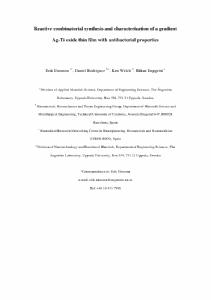Mostra el registre d'ítem simple
Reactive combinatorial synthesis and characterization of a gradient Ag-Ti oxide thin film with antibacterial properties
| dc.contributor.author | Unosson, Erik |
| dc.contributor.author | Rodríguez Rius, Daniel |
| dc.contributor.author | Welch, Ken |
| dc.contributor.author | Engqvist, Hakan |
| dc.contributor.other | Universitat Politècnica de Catalunya. Departament de Ciència dels Materials i Enginyeria Metal·lúrgica |
| dc.date.accessioned | 2015-06-26T09:05:25Z |
| dc.date.available | 2015-06-26T09:05:25Z |
| dc.date.created | 2015-01-01 |
| dc.date.issued | 2015-01-01 |
| dc.identifier.citation | Unosson, E. [et al.]. Reactive combinatorial synthesis and characterization of a gradient Ag-Ti oxide thin film with antibacterial properties. "Acta biomaterialia", 01 Gener 2015, vol. 11, p. 503-510. |
| dc.identifier.issn | 1742-7061 |
| dc.identifier.uri | http://hdl.handle.net/2117/28423 |
| dc.description.abstract | The growing demand for orthopedic and dental implants has spurred researchers to develop multifunctional coatings, combining tissue integration with antibacterial features. A possible strategy to endow titanium (Ti) with antibacterial properties is by incorporating silver (Ag), but designing a structure with adequate Ag+ release while maintaining biocompatibility has been shown difficult. To further explore the composition-structure-property relationships between Ag and Ti, and its effects against bacteria, this study utilized a combinatorial approach to manufacture and test a single sample containing a binary Ag-Ti oxide gradient. The sample, sputter-deposited in a reactive (O-2) environment using a custom-built combinatorial physical vapor deposition system, was shown to be effective against Staphylococcus aureus with viability reductions ranging from 17 to above 99%, depending on the amount of Ag+ released from its different parts. The Ag content along the gradient ranged from 35 to 62 wt.%, but it was found that structural properties such as varied porosity and degree of crystallinity, rather than the amount of incorporated Ag, governed the Ag+ release and resulting antibacterial activity. The coating also demonstrated in vitro apatite-forming abilities, where structural variety along the sample was shown to alter the hydrophilic behavior, with the degree of hydroxyapatite deposition varying accordingly. By means of combinatorial synthesis, a single gradient sample was able to display intricate compositional and structural features affecting its biological response, which would otherwise require a series of coatings. The current findings suggest that future implant coatings incorporating Ag as an antibacterial agent could be structurally enhanced to better suit clinical requirements. (C) 2014 Acta Materialia Inc. Published by Elsevier Ltd. All rights reserved. |
| dc.format.extent | 8 p. |
| dc.language.iso | eng |
| dc.rights | Attribution-NonCommercial-NoDerivs 3.0 Spain |
| dc.rights.uri | http://creativecommons.org/licenses/by-nc-nd/3.0/es/ |
| dc.subject | Àrees temàtiques de la UPC::Enginyeria biomèdica::Biomaterials |
| dc.subject.lcsh | Biomedical materials |
| dc.subject.other | Combinatorial materials science |
| dc.subject.other | Physical vapor deposition |
| dc.subject.other | Antibacterial |
| dc.subject.other | Silver |
| dc.subject.other | Titanium |
| dc.title | Reactive combinatorial synthesis and characterization of a gradient Ag-Ti oxide thin film with antibacterial properties |
| dc.type | Article |
| dc.subject.lemac | Implants dentals |
| dc.subject.lemac | Implants ortopèdics |
| dc.contributor.group | Universitat Politècnica de Catalunya. BBT - Biomaterials, Biomecànica i Enginyeria de Teixits |
| dc.identifier.doi | 10.1016/j.actbio.2014.09.048 |
| dc.description.peerreviewed | Peer Reviewed |
| dc.rights.access | Open Access |
| local.identifier.drac | 15519876 |
| dc.description.version | Postprint (author’s final draft) |
| dc.contributor.covenantee | Uppsala universitet |
| local.citation.author | Unosson, E.; Rodriguez, D.; Welch, K.; Engqvist, H. |
| local.citation.publicationName | Acta biomaterialia |
| local.citation.volume | 11 |
| local.citation.startingPage | 503 |
| local.citation.endingPage | 510 |
Fitxers d'aquest items
Aquest ítem apareix a les col·leccions següents
-
Articles de revista [960]
-
Articles de revista [439]


